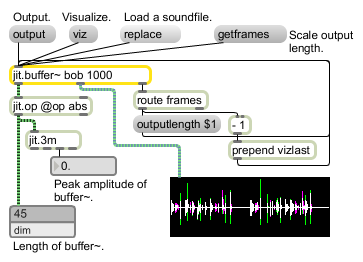| Name |
Type |
g/s |
Description |
| outputstart |
float |
|
The position in milliseconds to start collecting data from the buffer~ for an output matrix |
| outputlength |
float |
|
The length in milliseconds of the output matrix collected from the buffer~ |
| outputfirst |
int |
|
Frame at which to start collecting data from the buffer~ for an output matrix |
| outputlast |
int |
|
Frame at which to finish collecting data from the buffer~ for an output matrix |
| inputstart |
float |
|
An input matrix will be written to the buffer~ starting at this position in milliseconds |
| inputfirst |
int |
|
An input matrix will be written to the buffer~ starting at this frame |
| vizwidth |
int |
|
The width of the visualization output matrix (default=320) |
| vizheight |
int |
|
The height of the visualization output matrix (default=160) |
| vizchecktime |
int |
|
How often in milliseconds the visualization engine should check the status of the buffer~ and re-render the cache if necessary (default=250) |
| vizmode |
int |
|
A value of 1 turns on opaque rendering mode. A value of 2 turns on statistical rendering mode, which has greater detail but is more expensive to render. A value of 0 turns off visualization and all background processing of cached speedup data. (default=0) |
| vizstart |
float |
|
The position in milliseconds to start the render of the visualization output matrix |
| vizlength |
float |
|
The length in milliseconds to render for the visualization output matrix |
| vizfirst |
int |
|
Frame at which to start render of the visualization output matrix |
| vizlast |
int |
|
Frame at which to end render of the visualization output matrix |
| vizmemoryratio |
float |
|
Specifies the size of the data cache used to speed up rendering of the visualization matrix as a fraction of the data size of the buffer~ (deault=0.5) |

